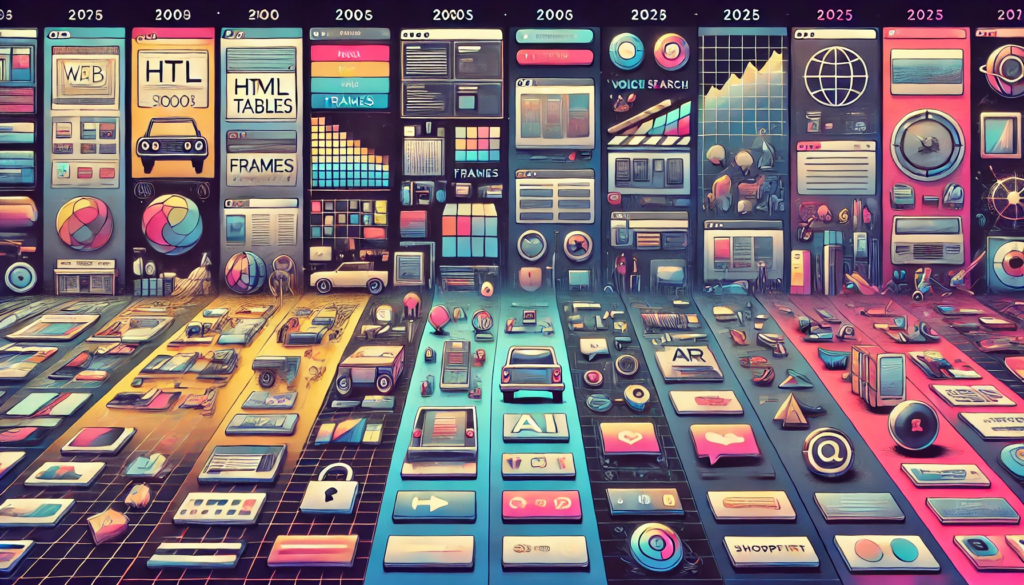The world of web design has undergone a remarkable transformation over the past two decades. From static HTML pages in the early 2000s to today’s dynamic, AI-driven designs, web design trends have subordinated to meet the demands of users and businesses alike. Let’s explore the key trends shaping web design from the 2000s to 2025 and how they impact modern websites.
We stay ahead of these trends at SUM Group to deliver cutting-edge solutions.
Instructions for Understanding the Evolution of Web Design
Step 1: Explore Early 2000s Trends
- Focus on Static Layouts: Websites in the early 2000s were often built using tables and frames, with minimal interactivity.
- Flash Animations: Flash was widely used for animations and multimedia elements, though it later became obsolete due to compatibility issues.
- Bright Colors and Patterns: Bold colours, gradients, and flashy graphics dominated the scene.
- SEO Basics: Search engine optimization (SEO) began gaining traction, with simple keyword stuffing being a common practice.
Step 2: Analyze Mid-2000s Advancements
- Introduction of CSS: Cascading Style Sheets (CSS) revolutionized design by separating content from presentation, enabling cleaner layouts.
- Rise of Blogs and CMS Platforms: Content Management Systems (CMS) like WordPress gained popularity, allowing non-developers to create websites effortlessly.
- Web 2.0: This era emphasized user-generated content, social media integration, and interactive features.
- Responsive Design Emergence: With the rise of smartphones, responsive design started becoming a priority.
Step 3: Study Late 2000s Innovations
- Minimalism and Simplicity: Clean designs with ample white space became popular, focusing on usability and clarity.
- Flat Design: Flat design replaced skeuomorphic elements, prioritizing simplicity and functionality.
- Mobile Optimization: As mobile usage surged, websites began adopting mobile-first approaches.
- E-commerce Boom: Platforms like Magento and Shopify transformed online shopping experiences.
Step 4: Examine 2010s Breakthroughs
- Parallax Scrolling: This technique creates depth and immersion by moving background images slower than foreground content.
- Material Design: Introduced by Google, Material Design brought consistency and intuitive interactions across platforms.
- Video Backgrounds: Full-screen video backgrounds added dynamism to homepages.
- Microinteractions: Small animations and feedback mechanisms enhanced user engagement.
Step 5: Look Ahead to 2020s Innovations
- AI and Automation: Artificial Intelligence powers chatbots, personalized recommendations, and automated workflows.
- Voice User Interfaces (VUIs): Nowadays, search optimisation is essential for modern websites.
- Dark Mode: Aesthetic and functional, dark mode reduces eye strain and saves battery life.
- Immersive Experiences: Augmented Reality (AR), Virtual Reality (VR), and 3D visuals are reshaping storytelling on the web.
Step 6: Predict Future Trends Until 2025
- Sustainability in Web Design: Eco-friendly practices, such as reducing energy consumption, will gain prominence.
- No-Code/Low-Code Tools: Platforms enabling drag-and-drop website creation will empower non-technical users.
- Hyper-Personalization: Advanced data analytics will allow websites to tailor content dynamically based on user behaviour.
- Progressive Web Apps (PWAs): PWAs combine the best web and mobile apps, offering offline functionality and fast load times.
The evolution of web design in 2026 reflects the rapid and fast advancements in technology and changing user expectations, and similar is applied to our best Web Design and Development services. By staying informed about these trends, businesses can create modern websites and deliver exceptional user experiences.
Ready to future-proof your website? Connect SUM Group

